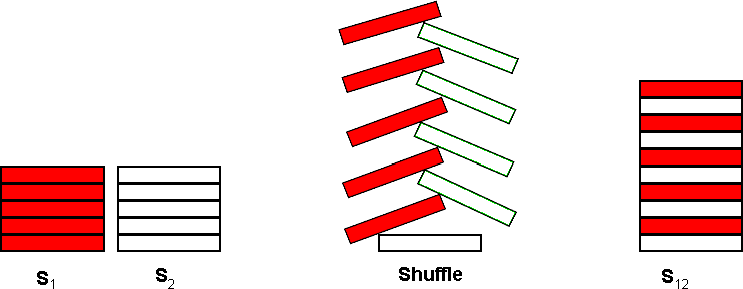poj 3087 Shuffle'm Up (模拟过程)
Description
A common pastime for poker players at a poker table is to shuffle stacks of chips. Shuffling chips is performed by starting with two stacks of poker chips, S1 and S2, each stack containing C chips. Each stack may contain chips of several different colors.
The actual shuffle operation is performed by interleaving a chip from S1 with a chip from S2 as shown below for C = 5:

The single resultant stack, S12, contains 2 * C chips. The bottommost chip of S12 is the bottommost chip from S2. On top of that chip, is the bottommost chip from S1. The interleaving process continues taking the 2nd chip from the bottom of S2 and placing that on S12, followed by the 2nd chip from the bottom of S1 and so on until the topmost chip from S1 is placed on top of S12.
After the shuffle operation, S12 is split into 2 new stacks by taking the bottommost C chips from S12 to form a new S1 and the topmost C chips from S12 to form a new S2. The shuffle operation may then be repeated to form a new S12.
For this problem, you will write a program to determine if a particular resultant stack S12 can be formed by shuffling two stacks some number of times.
Input
The first line of input contains a single integer N, (1 ≤ N ≤ 1000) which is the number of datasets that follow.
Each dataset consists of four lines of input. The first line of a dataset specifies an integer C, (1 ≤ C ≤ 100) which is the number of chips in each initial stack (S1 and S2). The second line of each dataset specifies the colors of each of the C chips in stack S1, starting with the bottommost chip. The third line of each dataset specifies the colors of each of the C chips in stack S2 starting with the bottommost chip. Colors are expressed as a single uppercase letter (A through H). There are no blanks or separators between the chip colors. The fourth line of each dataset contains 2 * C uppercase letters (A through H), representing the colors of the desired result of the shuffling of S1 and S2 zero or more times. The bottommost chip’s color is specified first.
Output
Output for each dataset consists of a single line that displays the dataset number (1 though N), a space, and an integer value which is the minimum number of shuffle operations required to get the desired resultant stack. If the desired result can not be reached using the input for the dataset, display the value negative 1 (−1) for the number of shuffle operations.
Sample Input
2
4
AHAH
HAHA
HHAAAAHH
3
CDE
CDE
EEDDCC
Sample Output
1 2
2 -1
大致题意:输入一个N,表示有N组数据,每组数据有四行,第一行是一个整数C,表示 每堆牌的数量,接下来是三行字符序列,第一行是S1堆,第二行是S2堆,第三行S12是预想的排序序列,求需要几步才能到达预想序列。
已知两堆牌s1和s2的初始状态, 其牌数均为c,按给定规则能将他们相互交叉组合成一堆牌s12,再将s12的最底下的c块牌归为s1,最顶的c块牌归为s2,依此循环下去。现在输入s1和s2的初始状态 以及 预想的最终状态s12.问s1 s2经过多少次洗牌之后,最终能达到状态s12,若永远不可能相同,则输出"-1"。
思路就是过程模拟,感觉最机智的就是用map<string,bool>vis,来标记字符序列了。
#include <iostream>
#include <cstring>
#include <map>
using namespace std;
const int maxn=;
char s1[maxn],s2[maxn];
char s12[maxn<<]; //预想的牌的状态
int main()
{
int n,c,cnt=;
cin>>n;
while(n--)
{
cin>>c;
cin>>s1>>s2>>s12;
int step=;
map<string,bool>vis;
vis[s12]=true;
while()
{
char temp[maxn<<];
int k=;
for(int i=;i<c;i++) //把s1和s2按照错乱顺序放到临时变量中
{
temp[k++]=s2[i];
temp[k++]=s1[i];
}
temp[k++]='\0';
step++;
if(strcmp(temp,s12)==) //如果和预设匹配,就输出步数
{
cout<<++cnt<<' '<<step<<endl;
break;
}
else if(vis[temp]&&strcmp(temp,s12)!=) //如果成环了,表示无法匹配了,输出-1
{
cout<<++cnt<<' '<<-<<endl;
break;
}
vis[temp]=true; //标记这个序列出现过
strncpy(s1,temp,c); //把temp数组的钱c个字符放进s1
strncpy(s2,temp+c,c); //把temp数组下面c个字符放进s2
s1[c]=s2[c]='\0';
// cout<<"--"<<s1<<"--"<<s2<<endl;
}
}
return ;
}
poj 3087 Shuffle'm Up (模拟过程)的更多相关文章
- POJ 3087 Shuffle'm Up (模拟+map)
题目链接:http://poj.org/problem?id=3087 题目大意:已知两堆牌s1和s2的初始状态, 其牌数均为c,按给定规则能将他们相互交叉组合成一堆牌s12,再将s12的最底下的c块 ...
- POJ 3087 Shuffle'm Up 模拟,看着不像搜索啊
题意:给定s1,s1两副扑克,顺序从下到上.依次将s2,s1的扑克一张一张混合.例如s1,ABC; s2,DEF. 则第一次混合后为DAEBFC. 然后令前半段为s1, 后半段为s2. 如果可以变换成 ...
- POJ.3087 Shuffle'm Up (模拟)
POJ.3087 Shuffle'm Up (模拟) 题意分析 给定两个长度为len的字符串s1和s2, 接着给出一个长度为len*2的字符串s12. 将字符串s1和s2通过一定的变换变成s12,找到 ...
- POJ 3087 Shuffle'm Up(洗牌)
POJ 3087 Shuffle'm Up(洗牌) Time Limit: 1000MS Memory Limit: 65536K Description - 题目描述 A common pas ...
- DFS POJ 3087 Shuffle'm Up
题目传送门 /* 题意:两块扑克牌按照顺序叠起来后,把下半部分给第一块,上半部给第二块,一直持续下去,直到叠成指定的样子 DFS:直接模拟搜索,用map记录该字符串是否被搜过.读懂题目是关键. */ ...
- POJ 3087 Shuffle'm Up
Shuffle'm Up Time Limit:1000MS Memory Limit:65536KB 64bit IO Format:%I64d & %I64u Submit ...
- poj 3087 Shuffle'm Up ( map 模拟 )
题目:http://poj.org/problem?id=3087 题意:已知两堆牌s1和s2的初始状态, 其牌数均为c,按给定规则能将他们相互交叉组合成一堆牌s12,再将s12的最底下的c块牌归为s ...
- POJ 3087 Shuffle'm Up(模拟)
Shuffle'm Up Time Limit: 1000MS Memory Limit: 65536K Total Submissions: 7404 Accepted: 3421 Desc ...
- POJ 3087 Shuffle'm Up【模拟/map/string】
Shuffle'm Up Time Limit: 1000MS Memory Limit: 65536K Total Submissions: 14471 Accepted: 6633 Descrip ...
随机推荐
- [Oracle,2018-02-07] Oracle 报错:“ORA-02292:违反完整约束条件(XXX.FKXXX)
报错的原因很清楚,就是你要删除的记录是另外某条记录的外键,解决办法: 1.删除子记录,在删除本记录: 2.暂时禁用此外键(适合在测试后清除所有记录的情况,记得最后要恢复此外键) 解决办法有了,现在最主 ...
- [解决]CXF wsdl2java 生成代码存在的一些问题
1.环境 CXF版本:3.2.4 JDK版本:1.8.0_112 2.问题 2.1.问题种类1 属性 "Value" 已定义.请使用 <jaxb:property> 解 ...
- spark-1
先测试搭好的spark集群: 本地模式测试: 在spark的目录下: ./bin/run-example SparkPi 10 --master local[2] 验证成功: 集群模式 Spark S ...
- thinkphp5.0 - Redis 实现秒杀
首先,因为秒杀这个环节在商城项目中比较常见,最近写商城项目,碰到这个功能模块,于是就拿出来给大家分享一波. 难点:高并发的情况下,正常逻辑写的话数据库的库存会出现负数,对付这类问题有很多解决方案,我就 ...
- Echarts 柱状图属性详解
<script type="text/javascript"> // 基于准备好的dom,初始化echarts实例 var myChart = echarts.init ...
- faster rcnn源码阅读笔记2
- 性感天才黑客乔治·霍兹George Hotz 17岁打脸乔布斯20岁搞疯索尼
1.国内外著名黑客信息 1) 国外著名黑客 George Hotz 乔治·霍兹(George Hotz,1989年10月2日-),美国学生,2007年8月解锁苹果(Apple)iPhone手机,使得i ...
- Halcon示例:print_quality 字符验证
read_image (Image, 'fonts/arial_a1')get_image_size (Image, Width, Height)dev_close_window ()dev_open ...
- js计算base64文件流大小
getImgSize(str) { //获取base64图片大小,返回KB数字 var str = base64url.replace('data:image/jpeg;base64,', '');/ ...
- socket failed: EACCES
参考 https://blog.csdn.net/ct_ts/article/details/80010208 <uses-permission android:name=“android.pe ...
